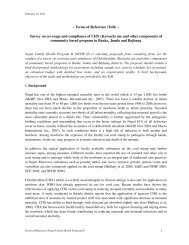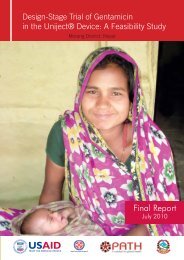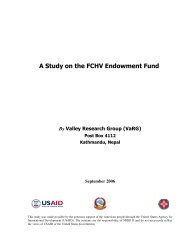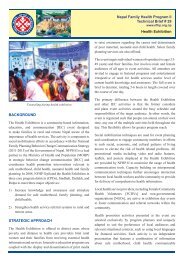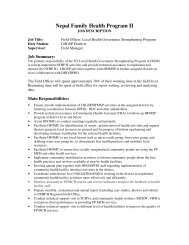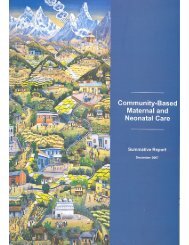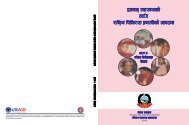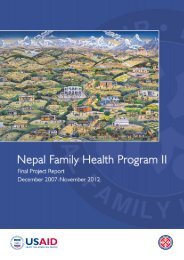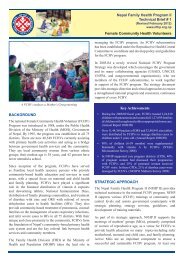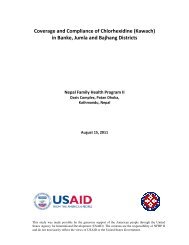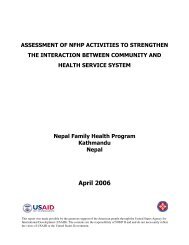Emerging Challenges in Family Planning Programme in Nepal
Emerging Challenges in Family Planning Programme in Nepal
Emerging Challenges in Family Planning Programme in Nepal
You also want an ePaper? Increase the reach of your titles
YUMPU automatically turns print PDFs into web optimized ePapers that Google loves.
Special Issue Articl<br />
J <strong>Nepal</strong> Health Res Counc 2012 May;10(21):108-12<br />
<strong>Emerg<strong>in</strong>g</strong> <strong>Challenges</strong> <strong>in</strong> <strong>Family</strong> Plann<strong>in</strong>g<br />
<strong>Programme</strong> <strong>in</strong> <strong>Nepal</strong><br />
Shrestha DR, 1 Shrestha A, 2 Ghimire J 1<br />
1<br />
Engender Health, <strong>Nepal</strong> <strong>Family</strong> Health Program II, 2JSI R&T Inc., <strong>Nepal</strong> <strong>Family</strong> Health Program II.<br />
ABSTRACT<br />
<strong>Family</strong> plann<strong>in</strong>g is a priority program of the Government of <strong>Nepal</strong>. Despite political <strong>in</strong>stability <strong>in</strong> the last two<br />
decades, <strong>Nepal</strong> has achieved remarkable progress <strong>in</strong> the overall status of reproductive health, <strong>in</strong>clud<strong>in</strong>g family<br />
plann<strong>in</strong>g. Married women of reproductive age have been <strong>in</strong>creas<strong>in</strong>gly us<strong>in</strong>g contraceptive from 1980s to2006.<br />
However, <strong>Nepal</strong> Demographic Health Survey 2011 has shown unexpected results on contraceptive prevalence rate.<br />
There had been a notable decl<strong>in</strong>e <strong>in</strong> the prevalence rate between 2006 and 2011, creat<strong>in</strong>g concerns among various<br />
stakeholders work<strong>in</strong>g <strong>in</strong> family plann<strong>in</strong>g programs. This paper analyzes this situation and identifies possible reasons<br />
for the stagnated contraceptive prevalence rate <strong>in</strong> <strong>Nepal</strong>. High proportion of spousal separation, an <strong>in</strong>creased use<br />
of traditional methods, abortion, emergency contraception, and a lack of <strong>in</strong>novative approaches to cater services<br />
to difficult-to-reach or special sub-groups are possible reasons. To improve the contraceptive prevalence, the family<br />
plann<strong>in</strong>g program should be implemented more strategically. Further data analysis, <strong>in</strong>itiation of best practices to<br />
fulfill family plann<strong>in</strong>g needs of special groups, functional <strong>in</strong>tegration of family plann<strong>in</strong>g services <strong>in</strong>to general health<br />
services, effective counsel<strong>in</strong>g and behavior change communication to prevent unwanted pregnancies, and <strong>in</strong>creased<br />
access to modern family plann<strong>in</strong>g methods could be the stepp<strong>in</strong>g stones to improve contraceptive prevalence rate and<br />
the overall FP program <strong>in</strong> <strong>Nepal</strong>.<br />
Keywords: abortion; emerg<strong>in</strong>g challenges spousal separation; emergency contraception; family plann<strong>in</strong>g; <strong>Nepal</strong>.<br />
INTRODUCTION<br />
The family plann<strong>in</strong>g programme started <strong>in</strong> develop<strong>in</strong>g<br />
countries <strong>in</strong> the 1960s to enhance prospects for<br />
socioeconomic development by reduc<strong>in</strong>g population<br />
growth. 1 In <strong>Nepal</strong>, the concept was <strong>in</strong>troduced <strong>in</strong> the<br />
same period. S<strong>in</strong>ce the beg<strong>in</strong>n<strong>in</strong>g, the Government of<br />
<strong>Nepal</strong> (GON) has implemented various approaches to<br />
fulfill family plann<strong>in</strong>g needs of <strong>in</strong>dividuals and couples.<br />
<strong>Family</strong> plann<strong>in</strong>g is now an <strong>in</strong>tegral part of the health<br />
system of <strong>Nepal</strong>. Despite political <strong>in</strong>stability and armed<br />
conflict <strong>in</strong> the last decade, <strong>Nepal</strong> has made remarkable<br />
progress <strong>in</strong> the use of modern contraceptives methods,<br />
especially dur<strong>in</strong>g the period between 1996 and 2006. 2<br />
<strong>Nepal</strong> has received <strong>in</strong>ternational awards for improv<strong>in</strong>g<br />
its maternal and child health status. 3,4 However, <strong>Nepal</strong><br />
Demographic Health Survey 2011 has shown unexpected<br />
results on contraceptive prevalence rate (CPR). Although<br />
CPR of all methods <strong>in</strong>creased from 48% <strong>in</strong> 2006 to 50%<br />
<strong>in</strong> 2011, there was a slight decrease <strong>in</strong> CPR of modern<br />
methods from 44.2% to 43.2% dur<strong>in</strong>g the same period. 2<br />
The sudden break <strong>in</strong> the momentum of CPR was a cause<br />
for concern for stakeholders work<strong>in</strong>g <strong>in</strong> this area.<br />
This paper, last <strong>in</strong> the six article series, aims to identify<br />
possible factors for this decl<strong>in</strong>e and ways to address<br />
them for better results.<br />
LITERATURE REVIEW<br />
Secondary desk review was conducted for this article.<br />
Authors looked at published documents, reports, journal<br />
articles, as well as relevant websites.<br />
Correspondence: Mr. Dirgha Raj Shrestha, <strong>Nepal</strong> <strong>Family</strong> Health Program II, Oasis<br />
complex, Patan Dhoka, PO Box 1600, Kathmandu, <strong>Nepal</strong>. Email: dshrestha@nfhp.org.np,<br />
Phone: +977-9851074163.<br />
108<br />
JNHRC Vol. 10 No. 2 Issue 21 May 2012
<strong>Emerg<strong>in</strong>g</strong> <strong>Challenges</strong> <strong>in</strong> <strong>Family</strong> Plann<strong>in</strong>g Program <strong>in</strong> <strong>Nepal</strong><br />
Current <strong>Family</strong> Plann<strong>in</strong>g Service Delivery System <strong>in</strong><br />
<strong>Nepal</strong><br />
<strong>Family</strong> plann<strong>in</strong>g (FP) is a priority programme of the M<strong>in</strong>istry<br />
of Health and Population (MoHP) and a component of the<br />
reproductive health package and essential health care<br />
services of the <strong>Nepal</strong> Health Sector Program II (2010-<br />
2015). 5 FP services are available through government,<br />
social market<strong>in</strong>g, and private health facilities and<br />
are available free of cost <strong>in</strong> public health facilities.<br />
Currently, temporary FP methods (male condoms, pill,<br />
and <strong>in</strong>jectables) are provided on a regular basis through<br />
health posts, sub health posts, primary health care<br />
Outreach Cl<strong>in</strong>ics, and periphery level health workers and<br />
volunteers (condoms and resupply of pills). Methods such<br />
as IUCD and implants are available at selected hospitals,<br />
primary health care centers, and health posts where<br />
tra<strong>in</strong>ed human resource is available. 6 Depend<strong>in</strong>g on the<br />
district, sterilization services are provided at static sites<br />
or through scheduled “seasonal” or mobile outreach<br />
services. Almost all district FP maternal and child health<br />
(MCH) cl<strong>in</strong>ics supply all temporary FP methods. 7<br />
FP services are also available through social market<strong>in</strong>g at<br />
subsidised rates through different outlets and available<br />
free of cost <strong>in</strong> select cl<strong>in</strong>ics and hospitals managed by<br />
non-governmental organizations. Private cl<strong>in</strong>ics and<br />
hospitals also provide paid FP services.<br />
Review of <strong>Family</strong> Plann<strong>in</strong>g <strong>Programme</strong> <strong>in</strong> <strong>Nepal</strong><br />
There are a number of <strong>in</strong>dicators to measure the progress<br />
of the family plann<strong>in</strong>g programme, however, the MOHP<br />
has selected three impact <strong>in</strong>dicators; total fertility<br />
rate (TFR), adolescent fertility rate (AFR), and CPR as<br />
a part of the Millennium Development Goals (MDGs). 5<br />
The MOHP aims to reduce TFR from 5.3 to 2.5 children<br />
per woman from 1991 to 2015 and adolescent fertility<br />
rate from 127to 70 per 1000 adolescents from 1996 to<br />
2015; and <strong>in</strong>crease CPR from 24 to 67 percent from1991<br />
to 2015. 5 This article will analyze the situation of the<br />
family plann<strong>in</strong>g program <strong>in</strong> <strong>Nepal</strong> primarily <strong>in</strong> relation<br />
to the above three <strong>in</strong>dicators, but not limit<strong>in</strong>g to them<br />
shows the trend <strong>in</strong> CPR over time. CPR <strong>in</strong>creased from<br />
3 percent <strong>in</strong> 1976 to 48 percent <strong>in</strong> 2006 (Figure 1). 8<br />
However, after 2006, it has rema<strong>in</strong>ed constant. The NDHS<br />
2011 has shown CPR to have <strong>in</strong>creased marg<strong>in</strong>ally to 50%<br />
for all methods, while a small decl<strong>in</strong>e was observed <strong>in</strong><br />
CPR of modern methods, <strong>in</strong>dicat<strong>in</strong>g difficulty to achieve<br />
the target of 67% by 2015. 2<br />
AFR was 145 per 1000 adolescents <strong>in</strong> 1976, reduc<strong>in</strong>g to<br />
127 by 1996, 98 by 2006 and 81 <strong>in</strong> 2011. 2,10 If the current<br />
trend cont<strong>in</strong>ues, <strong>Nepal</strong> will achieve the MDG target to<br />
reduce AFR to 70 by 2015.<br />
Figure 1. Contraceptive prevalence rate (1976 –<br />
2011) 2,8,9<br />
Figure 2. Trends of total fertility rate <strong>in</strong> <strong>Nepal</strong>, 1976-<br />
2011 2,8,9<br />
<strong>Nepal</strong> had high TFR until 1991, after which it decl<strong>in</strong>ed<br />
from 5.09 to 2.6 <strong>in</strong> 2011, <strong>in</strong>dicat<strong>in</strong>g that <strong>Nepal</strong> is likely<br />
to achieve the MDG target of 2.5 by 2015. 2<br />
There has been improvement <strong>in</strong> method mix. In 1986,<br />
the proportion of VSC to spac<strong>in</strong>g was 84% to 16%. 9 In<br />
2011, the ratio had changed to 46% to 54%. 2 Despite<br />
these positive changes, female sterilization is still the<br />
most widely used FP method, but the use of IUCDs and<br />
implants is still very low.<br />
The percentage of planned pregnancies is <strong>in</strong>creas<strong>in</strong>g:<br />
accord<strong>in</strong>g to the NDHS 2011, 74.4% (three <strong>in</strong> four births)<br />
<strong>in</strong> the five years preced<strong>in</strong>g the survey were planned, 12%<br />
were mistimed, and 13% were unwanted. 2 The level of<br />
knowledge of at least one modern FP method <strong>in</strong> <strong>Nepal</strong> is<br />
almost universal among both women and men. 8 However,<br />
a more comprehensive knowledge on family plann<strong>in</strong>g<br />
methods is still limited.<br />
In addition to the above <strong>in</strong>dicators, there has been a<br />
steady decl<strong>in</strong>e <strong>in</strong> the preferred number of children. The<br />
mean ideal number of children among currently married<br />
women over the last fifteen years decreased from 2.9<br />
children <strong>in</strong> 1996 to 2.1 children <strong>in</strong> 2011. Nationally,<br />
the proportion of teenage pregnancies decl<strong>in</strong>ed from<br />
24 percent <strong>in</strong> 1996, 21% <strong>in</strong> 2001, 19% <strong>in</strong> 2006, and to<br />
JNHRC Vol. 10 No. 2 Issue 21 May 2012 109
<strong>Emerg<strong>in</strong>g</strong> <strong>Challenges</strong> <strong>in</strong> <strong>Family</strong> Plann<strong>in</strong>g Program <strong>in</strong> <strong>Nepal</strong><br />
17% <strong>in</strong> 2011. 2 Birth <strong>in</strong>terval <strong>in</strong>creased from 32 months<br />
<strong>in</strong> 1996, 34 months <strong>in</strong> 2006, and to 36 months <strong>in</strong> 2011, 2,8<br />
show<strong>in</strong>g that <strong>in</strong>dividuals or couples <strong>in</strong> <strong>Nepal</strong> desire fewer<br />
children and use spac<strong>in</strong>g methods.<br />
Unmet need is another important <strong>in</strong>dicator of the family<br />
plann<strong>in</strong>g programme. In <strong>Nepal</strong>, unmet need decl<strong>in</strong>ed<br />
noticeably between 1996 to 2006, fall<strong>in</strong>g from 31% <strong>in</strong><br />
1996, 28 percent <strong>in</strong> 2001, and to 25 percent <strong>in</strong> 2006. 8<br />
However, the NDHS 2011 shows slight <strong>in</strong>crease <strong>in</strong> unmet<br />
need for FP (27%). 2<br />
Overall, there is improv<strong>in</strong>g trends <strong>in</strong> FP- related <strong>in</strong>dicators<br />
except CPR and unmet need <strong>in</strong> <strong>Nepal</strong>. The stagnation <strong>in</strong><br />
the last couples of years is not only a problem for <strong>Nepal</strong>,<br />
but also for other develop<strong>in</strong>g countries as the annual<br />
rate of <strong>in</strong>crease <strong>in</strong> CPR <strong>in</strong> almost all regions was lower<br />
than it had been dur<strong>in</strong>g 1990s. 11<br />
Factors Contribut<strong>in</strong>g to Stagnation <strong>in</strong> CPR<br />
Under this section, we discuss five different<br />
demographic and programmatic factors that may offer<br />
some explanation as to why CPR has not <strong>in</strong>creased <strong>in</strong><br />
the recent past. Each factor is exam<strong>in</strong>ed separately, but<br />
some of them may be related and may expla<strong>in</strong> the reason<br />
for non-use of family plann<strong>in</strong>g methods; for example<br />
spousal separation may be associated with the use of<br />
emergency contraception or even abortions. Further<br />
analysis of NDHS 2011 on the determ<strong>in</strong>ants of fertility<br />
will shed more light on this subject. Possible reasons for<br />
the stagnation <strong>in</strong> CPR are described below.<br />
High Spousal Separation<br />
Data from the Department of Foreign Employment<br />
Promotion <strong>in</strong> 2009–10 shows that <strong>Nepal</strong>ese migrate<br />
to work <strong>in</strong> 105 countries globally, mostly to India,<br />
Malaysia, Qatar, Saudi Arabia, UAE, Korea, Japan,<br />
England, and so forthe. This trend of out-migration<br />
has been <strong>in</strong>creas<strong>in</strong>g over the years, particularly among<br />
males. 12 The prelim<strong>in</strong>ary f<strong>in</strong>d<strong>in</strong>gs of the Census 2010<br />
shows that among the total population of 28 million,<br />
about 2 million were out of the country, of which the<br />
majority are <strong>in</strong> the reproductive age group. 13 The Midterm<br />
Survey by the <strong>Nepal</strong> <strong>Family</strong> Health Program II<br />
(NFHP II) <strong>in</strong> 2008/2009 and the NDHS 2011 also showed<br />
similar result - 32% or about one third of couples were<br />
separated due to migration. Spousal separation does not<br />
necessarily imply an absence of coital activity; yet, the<br />
FP needs of separated couples differ significantly from<br />
those who are cohabit<strong>in</strong>g. 14 Wives of the migrants who<br />
are us<strong>in</strong>g temporary methods discont<strong>in</strong>ue, <strong>in</strong> order to<br />
avoid rumors about <strong>in</strong>fidelity when their husbands are<br />
away from home. The data from NDHS 2011 showed that<br />
the most common reason for discont<strong>in</strong>u<strong>in</strong>g FP methods<br />
is husband liv<strong>in</strong>g away (40%). On the other hand, the<br />
Mid-term Survey also showed that of the couples who<br />
were liv<strong>in</strong>g together, 62% were us<strong>in</strong>g some type of FP<br />
methods. 2,15<br />
A recent qualitative study conducted by NFHP II <strong>in</strong> 2012<br />
regard<strong>in</strong>g FP needs of migrant couples <strong>in</strong> <strong>Nepal</strong> revealed<br />
that a majority of wives of migrant males do not make<br />
any prior arrangements on the use of FP methods<br />
before the husbands return at home. In addition, very<br />
few couples used a FP method dur<strong>in</strong>g the first night of<br />
sexual <strong>in</strong>tercourse. Wives of male migrants face barriers<br />
such as fear of be<strong>in</strong>g accused of <strong>in</strong>fidelity, denial of FP<br />
services by service providers, and reservations with<br />
regards to ask<strong>in</strong>g for FP services when their husbands<br />
are away from home. 16 Because all married women of<br />
reproductive age are <strong>in</strong>cluded <strong>in</strong> the denom<strong>in</strong>ator when<br />
calculat<strong>in</strong>g CPR, it has contributed to the decl<strong>in</strong>e <strong>in</strong><br />
CPR. In a sett<strong>in</strong>g where spousal absence is common and<br />
<strong>in</strong>creas<strong>in</strong>g, assess<strong>in</strong>g FP program performance us<strong>in</strong>g<br />
conventional measures of contraceptive prevalence and<br />
unmet need may be mislead<strong>in</strong>g. 14<br />
Increase <strong>in</strong> Traditional Methods<br />
The use of FP methods like rhythm and withdrawal<br />
protect pregnancies to some extent but are less<br />
effective than modern methods. The FP programme<br />
does not promote traditional methods. However, there<br />
has been an <strong>in</strong>crease<strong>in</strong> us<strong>in</strong>g these methods <strong>in</strong> the last<br />
two decades. Only 1% of currently married women were<br />
us<strong>in</strong>g any type of traditional methods <strong>in</strong> 1991, 9 <strong>in</strong>creas<strong>in</strong>g<br />
to 2.5% <strong>in</strong> 1996, 3.9% <strong>in</strong> 2001 and 3.7% <strong>in</strong> 2006. 7 However,<br />
accord<strong>in</strong>g to NDHS 2011, use of any traditional methods<br />
almost doubled (6.5 %), 2 which may have contributed to<br />
a reduction <strong>in</strong> the CPR of modern FP methods. Effective<br />
counsel<strong>in</strong>g, behavior change and communication<br />
approaches, and <strong>in</strong>creas<strong>in</strong>g the availability of modern<br />
methods could help people switch from traditional to<br />
modern methods.<br />
Increase <strong>in</strong> Access And Use Of Abortion<br />
Due to the <strong>in</strong>troduction of medical abortion technology,<br />
abortion services are more easily available below district<br />
level <strong>in</strong> the government and majority of private health<br />
facilities. <strong>Nepal</strong> began provid<strong>in</strong>g comprehensive abortion<br />
care (CAC) services <strong>in</strong> 2004 through government, nongovernment,<br />
and private health <strong>in</strong>stitutions, wlhich are<br />
now available <strong>in</strong> all 75 districts. 16-18 In the government<br />
sector, CAC services have extended to the primary<br />
health care center level. Due to the easy availability<br />
of abortion services, the number of women seek<strong>in</strong>g<br />
abortions has been <strong>in</strong>creas<strong>in</strong>g every year (see figure<br />
3). 19-22 The number of abortion cases is recorded only<br />
at certified CAC sites, but many abortion cases occur <strong>in</strong><br />
non CAC, certified sites, which is not recorded properly.<br />
110<br />
JNHRC Vol. 10 No. 2 Issue 21 May 2012
<strong>Emerg<strong>in</strong>g</strong> <strong>Challenges</strong> <strong>in</strong> <strong>Family</strong> Plann<strong>in</strong>g Program <strong>in</strong> <strong>Nepal</strong><br />
Therefore, estimates of the annual number of abortion<br />
cases are significantly higher than official statistics.<br />
modified and tailored to meet the needs of these subgroups<br />
among the population.<br />
Figure 3.Trends of CAC service users 19-22<br />
A study conducted at the Maternity Hospital, Kathmandu<br />
<strong>in</strong> 2005 revealed that among the abortion clients, 97%<br />
were married and liv<strong>in</strong>g together with their spouse<br />
and the average number of children was only two. The<br />
majority (57.4%) of women did not want another child.<br />
Among them, about three out of five women (61.5%)<br />
reported us<strong>in</strong>g a method to space or prevent unwanted<br />
pregnancies before. 23 A similar study conducted at the<br />
same hospital <strong>in</strong> 2009 found that 56 percent reported<br />
us<strong>in</strong>g FP methods. 24 Many of the abortions could have been<br />
avoided through the use of effective contraceptives. 23<br />
Increase <strong>in</strong> Use of Emergency Contraception<br />
Although Emergency Contraception (EC) is part of the<br />
FP programme, there is no system <strong>in</strong> place with<strong>in</strong> the<br />
government's health <strong>in</strong>formation system to collect data<br />
about the use of EC. PSI/<strong>Nepal</strong> <strong>in</strong>itiated "Post<strong>in</strong>or 2" as<br />
a part of social market<strong>in</strong>g efforts <strong>in</strong> June 2004 through<br />
select outlets. CRS also started market<strong>in</strong>g "Post<strong>in</strong>or 2"<br />
<strong>in</strong> 2005. In June 2009, CRS launched the "E-Con", which<br />
is available all over <strong>Nepal</strong>. In addition to these, Indian<br />
brands are available <strong>in</strong> the market, for which the number<br />
of sale is unknown. However, it is clear that the sale of<br />
EC <strong>in</strong>creased remarkably <strong>in</strong> the last five years. There<br />
was a three-fold <strong>in</strong>crease <strong>in</strong> the sale of EC between FY<br />
2008/09 to 2009/10. 21,22 In FY 2010/11, CRS alone sold<br />
247,776 packets of EC <strong>in</strong> <strong>Nepal</strong>. 6 There is a possibility<br />
that <strong>in</strong>dividuals and couples may opt to use EC to prevent<br />
pregnancies rather than for unprotected sex.<br />
Reposition<strong>in</strong>g FP <strong>Programme</strong>s<br />
In the past decade, a lot has changed with regards to the<br />
reproductive health needs of <strong>in</strong>dividuals and couples.<br />
Although current family plann<strong>in</strong>g approaches have been<br />
able to fulfill FP needs of certa<strong>in</strong> groups of people,<br />
there are other groups whose needs have not been met.<br />
Unmet FP need is high among married adolescents,<br />
residents of rural areas, hill and mounta<strong>in</strong> regions, and<br />
certa<strong>in</strong> ethnic groups. There are also about one third of<br />
wives whose husband are away from home with different<br />
FP needs. The FP strategies and approaches have to be<br />
Figure 4. Trends of sales of emergency contraception<br />
“Econ” 6,19-22<br />
WAY FORWARD<br />
To strengthen FP services <strong>in</strong> the country, especially for<br />
the rural and marg<strong>in</strong>alised communities, all concerned<br />
<strong>in</strong>dividuals and organisations need to collaborate and<br />
harmonize their programmes. First, it is necessary to<br />
further analyze the data to identify factors contribut<strong>in</strong>g<br />
to the gap and accord<strong>in</strong>gly plan the programmes that<br />
address them. The FP programme should adopt best<br />
practices to fulfill FP needs of special groups like<br />
migrants, postpartum and post-abortion mothers,<br />
married adolescents, poor <strong>in</strong>dividuals/couples liv<strong>in</strong>g <strong>in</strong><br />
rural, hill and mounta<strong>in</strong> areas as the exist<strong>in</strong>g general<br />
programme cannot effectively fulfill their needs.<br />
Although family plann<strong>in</strong>g is <strong>in</strong>tegrated with<strong>in</strong> the<br />
general health system of <strong>Nepal</strong>, it could be more<br />
effectively <strong>in</strong>tegrated <strong>in</strong>to maternal health (antenatal,<br />
delivery, post natal, morbidity cl<strong>in</strong>ics), child health<br />
(immunization, growth monitor<strong>in</strong>g, general check<br />
up), HIV/AIDS, CAC, and post abortion care services.<br />
In addition, when women of reproductive age or their<br />
spouse visit health facilities, s<strong>in</strong>cere attempts should be<br />
made to provide them with FP <strong>in</strong>formation and services.<br />
Use of emergency contraception and abortion are<br />
<strong>in</strong>creas<strong>in</strong>g steadily <strong>in</strong> <strong>Nepal</strong>. Both methods prevent<br />
unwanted pregnancies <strong>in</strong> certa<strong>in</strong> circumstances,<br />
therefore are essential components of reproductive<br />
health. However, this <strong>in</strong>crease is a sign of failure of<br />
the family plann<strong>in</strong>g programme. It is not wise to use<br />
emergency contraception and abortion as alternatives<br />
to family plann<strong>in</strong>g methods. The FP programme should<br />
therefore develop a strategy to <strong>in</strong>crease awareness about<br />
the importance of FP to prevent unwanted pregnancies<br />
and discourage the use of emergency contraception and<br />
abortion as a method of FP.<br />
JNHRC Vol. 10 No. 2 Issue 21 May 2012 111
<strong>Emerg<strong>in</strong>g</strong> <strong>Challenges</strong> <strong>in</strong> <strong>Family</strong> Plann<strong>in</strong>g Program <strong>in</strong> <strong>Nepal</strong><br />
Healthy tim<strong>in</strong>g and spac<strong>in</strong>g of pregnancy have many<br />
benefits for mothers, children and family members, but<br />
many people are still unaware of the right time of first<br />
pregnancy and the healthy spac<strong>in</strong>g period. Messages<br />
about healthy tim<strong>in</strong>g and spac<strong>in</strong>g should be widely<br />
dissem<strong>in</strong>ated down to the community level through<br />
effective BCC approaches. Studies and programmes<br />
implemented <strong>in</strong> other countries have already proven<br />
that FP is the best approach to improve the health,<br />
economy, education, environment and overall quality of<br />
life. 24 Advocacy should be done widely from the center<br />
to the community level about the importance of FP<br />
for generation of additional resources and creat<strong>in</strong>g an<br />
enabl<strong>in</strong>g environment.<br />
<strong>Nepal</strong> has faced demographic challenges due to the<br />
high rate of spousal separation caused by migration for<br />
employment. In the current situation, the conventional<br />
methods of calculat<strong>in</strong>g CPR and unmet need do not give<br />
the real picture of the country. Discussions should be<br />
held to identify the proper way of calculat<strong>in</strong>g CPR and<br />
unmet need of the country by disaggregat<strong>in</strong>g FP use by<br />
the residence status of husbands. 14 This will provide a<br />
real picture of CPR and unmet need <strong>in</strong> the countries with<br />
high spousal separation due to migration.<br />
ACKNOWLEDGEMENTS<br />
We would like to thank Dr. Shilu Adhikari, Mr. Bharat<br />
Ban, Ms. Shriya Pant, Mr. Kanak Shrestha, and Ms. Radha<br />
Rai for their <strong>in</strong>puts dur<strong>in</strong>g the preparation of this article.<br />
CONFLICT OF INTEREST<br />
We declare no conflict of <strong>in</strong>terest for this article.<br />
REFERENCES<br />
1. Cleland J, Bernste<strong>in</strong> S, Ezeh A, Faundes A, Glasier A, Innis<br />
J. <strong>Family</strong> plann<strong>in</strong>g: the unf<strong>in</strong>ished agenda. Lancet. 2006 Nov<br />
18;368(9549):1810-27.<br />
2. M<strong>in</strong>istry of Health & Population, New Era, ICF Macro, USAID.<br />
<strong>Nepal</strong> Demographic and Health Survey 2011. Kathmandu:<br />
M<strong>in</strong>istry of Health and Population; 2012.<br />
3. Nyaya Health. <strong>Nepal</strong> receives award for decrease<strong>in</strong>g maternal<br />
mortality, but challenges and disparities rema<strong>in</strong>. 2010 [Cited<br />
2012 March 6]; Available from: http://blog.nyayahealth.<br />
org/2010/10/04/mdgaward/.<br />
4. M<strong>in</strong>isterial Leadership Initiative. <strong>Nepal</strong> Receives GAVI award<br />
for outstand<strong>in</strong>g perfomrance <strong>in</strong> improv<strong>in</strong>g child health and<br />
immunization. 2009; Available from: http://blog.nyayahealth.<br />
org/2010/10/04/mdgaward/.<br />
5. Government of <strong>Nepal</strong>. <strong>Nepal</strong> Health Sector Program-II (2010-<br />
2015). <strong>Nepal</strong>: M<strong>in</strong>istry of Health and Population; 2010.<br />
6. Department of Health Services. Annual Report 2010/2011.<br />
Kathmandu, <strong>Nepal</strong>. 2011.<br />
7. <strong>Family</strong> Health Division. National <strong>Family</strong> Plann<strong>in</strong>g Service Delivery<br />
Guidel<strong>in</strong>es. Kathmandu: M<strong>in</strong>istry of Health and Population; 2006.<br />
8. M<strong>in</strong>istry of Health & Population, New Era, ICF Macro, USAID.<br />
<strong>Nepal</strong> Demographic and Health Survey 2006. Kathmandu:<br />
M<strong>in</strong>istry of Health and Population; 2007.<br />
9. Pradhan A, Aryal RH, Regmi G, Ban B, Gov<strong>in</strong>dasamy P. <strong>Family</strong><br />
Health Survey 1996. Kathmandu: M<strong>in</strong>istry of Health, New ERA,<br />
Macro International Inc.;1997.<br />
10. Karki YB, Krishna R. Responsible for the Rapid Decl<strong>in</strong>e of Fertility<br />
<strong>in</strong> <strong>Nepal</strong>- An Interpretation: Further Analysis of the 2006 <strong>Nepal</strong><br />
Demographic and Health Survey. Claverton, Maryland, USA:<br />
Macro International Inc; 2008.<br />
11. United Nations. Millenium Development Goals Report. New<br />
York; 2010.<br />
12. Sharma JR. The impact of environmental change on labour<br />
migration from <strong>Nepal</strong> to the Gulf States. In: Migration and Global<br />
Environmental Change, editor.October, 2011 p. 3-11.<br />
13. Central Bureau of Statistics, National Plann<strong>in</strong>g Commission,<br />
Government of <strong>Nepal</strong>. Population census prelim<strong>in</strong>ary report<br />
2011. Central Bureau of Statistics; 2011.<br />
14. Ban B, Karki S, Shrestha A, Hodg<strong>in</strong>s S. Spousal separation and<br />
<strong>in</strong>terpretation of contraceptive use and unmet need <strong>in</strong> rural <strong>Nepal</strong>.<br />
Int Perspect Sex Reprod Health. 2012 March;38(1):43-7.<br />
15. <strong>Nepal</strong> <strong>Family</strong> Health Program II, New ERA. <strong>Family</strong> Plann<strong>in</strong>g,<br />
Maternal, Newborn and Child Health Situation <strong>in</strong> Rural <strong>Nepal</strong>: A<br />
Mid-term Survey for NFHP II. 2010.<br />
16. <strong>Nepal</strong> <strong>Family</strong> Health Program, Centre for Research on<br />
Environment Health and Polulation Activities. <strong>Family</strong> Plann<strong>in</strong>g<br />
Needs of Migrants Couples <strong>in</strong> <strong>Nepal</strong>. 2012.<br />
17. Puri M. Situational analysis on unsafe abortion <strong>in</strong> <strong>Nepal</strong> Thapathali,<br />
Kathmandu: Centre for Research on Environment Health and<br />
Population Activities (CREHPA), <strong>Nepal</strong> Society for Obstetrician<br />
and Gynaecologists (NESON); 2008.<br />
18. Population Health and Development (PHD) Group. An<br />
Exploratory Study of Complications from CAC: Improvement of<br />
the Quality of Comprehensive Abortion Care (CAC) Services <strong>in</strong><br />
<strong>Nepal</strong>. Kathmandu: <strong>Family</strong> Health Division, M<strong>in</strong>istry of Health,<br />
Ipas-<strong>Nepal</strong>; 2008.<br />
19. Department of Health Services, Management Division. Annual<br />
Report 2006/07. Kathmandu: M<strong>in</strong>istry of Health and Population;<br />
2007.<br />
20. Department of Health Services, Management Division. Annual<br />
Report 2007/08. Kathmandu: M<strong>in</strong>istry of Health and Population;<br />
2008.<br />
21. Department of Health Services, Management Division. Annual<br />
Report 2008/09. Kathmandu: M<strong>in</strong>istry of Health and Population;<br />
2009.<br />
22. Department of Health Services, Management Division. Annual<br />
Report 2009/10. Kathmandu: M<strong>in</strong>istry of Health and Population;<br />
2010.<br />
23. Thapa S, Malla K, Basnet I. Safe Abortion Services <strong>in</strong> <strong>Nepal</strong>: Initial<br />
Years of Availability and Utilization. World Health & Population.<br />
2010;11(3):55-66.<br />
24. Bajracharya L, Basnet I, Neupane S, KC NP, Thapa S. Clients of<br />
Abortion Services at the Maternity Hospital : Results of a 2010<br />
Survey; 2010.<br />
112<br />
JNHRC Vol. 10 No. 2 Issue 21 May 2012



